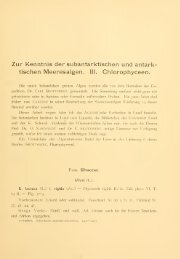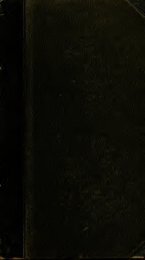Download PDF
Download PDF
Download PDF
Create successful ePaper yourself
Turn your PDF publications into a flip-book with our unique Google optimized e-Paper software.
SPIROGYRA 127<br />
may be widened and nearly disappear, leaving the tubes "appar-<br />
ently formed by the male gametangia."<br />
Another matter that must be determined early in the use of<br />
the key concerns the growth of the female, or receptive, gametangia<br />
during conjugation. Do they remain cylindric, or become<br />
slightly enlarged, or greatly distended or inflated ? The two latter<br />
conditions we judge by the enlargement relative to the thickness<br />
of the spore. If the spore just fits the distended part of the gametangium<br />
it is enlarged. If gametangial walls are much more<br />
distended than the diameter of the spore, the gametangium is<br />
inflated. The inflation may be only on the conjugating, or inner,<br />
side, or it may be only on the opposite, or outer, side. In many<br />
species the inflation is on both sides.<br />
The gametangial walls are not distended by the spore walls.<br />
Contrariwise the spore dimensions and forms are often limited by<br />
the gametangial walls. One can find many examples to prove this<br />
where spores formed in small gametangia are variously deformed<br />
by the rigidity of the gametangial wall.<br />
Another interesting fact is that there is no proportional relation<br />
between the combined volumes of the gametangia and the volumes<br />
of the spores in different species. Spore sizes in the same<br />
species, however, are usually larger or smaller depending upon<br />
whether the volumes of the gametangia are larger or smaller than<br />
the average.<br />
It is noteworthy that small spores in large gametangia are not<br />
free to move about as the cell is turned. The spores in all the<br />
Zygnemataceae are more or less fixed in position by an extremely<br />
dilute pectic gel that fills the entire cavity of the "empty" gam-<br />
etangia and sporangia. If these spaces were filled with water alone<br />
the position of the spores could be changed readily.<br />
The last essential feature of the description of a Spirogyra is<br />
the number of spore walls, the color, and surface markings of<br />
each. The kinds of ornamentation are best shown by illustrations.<br />
Not all drawings are equally satisfactory, but some of the most<br />
difficult have been sketched with remarkable accuracy.<br />
Spore wall features should be seen through an oil immersion<br />
lens, so that one can be sure to distinguish between the shadows<br />
of spore contents and actual wall structures. In drawing spores<br />
the contents should be omitted, since they are of no taxonomic<br />
value, while the wall characteristics have great importance.




